
|
Sale 14
Coins, Collectibles and Memorabilia Auction
| Other Ancient Glass & Antiquities |
| |
| |
| Lot |
Photo |
Description |
Realized |
Lot 4838 |
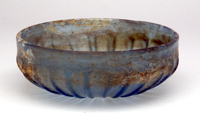 |
Choice Cast and Molded Ribbed Bowl in Blue. Cf. Sammlung Oppenlander no. 254. Roman, Italy or Levant, late 1st century BC. to mid-1st century AD. The cast bowl of shallow phiale-like form, with concave base, and twenty-four radiating ribs on the exterior. As is usual for this class, the exterior smoothed by "fire polishing, the interior polished with lapidary techniques, along with three wheel-cut grooves as ornament within. Some light, cleanable calcareous patina outer sides, and slight traces of iridescence. Intact and choice, without any of the large age cracks these heavy, cast pieces seem to accumulate. Diameter: 5-1/4". A key piece of early glass for any advanced collection.
Estimated Value $1,500 - 2,000.
View details and enlarged photo
| Realized
$2,013 |
Lot 4839 |
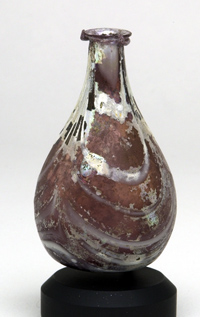 |
Ribbon Glass Bottle in White and Violet. Roman, 1st century AD. Cf. Sammlung Oppenlander, nos. 358, 367. Little bottle of plump piriform shape, with small everted rim and flattened bottom. The bands of opaque white have been marvered into a symmetrical design of swags or gadroons. Intact and very fine, with areas of opaque silvery to metallic iridescence in soft greens, violets and magentas. Height: 2-/7/8", on custom stand. A fine example of this desirable class of early Imperial glass.
Estimated Value $900-UP.
View details and enlarged photo
| Realized
$1,150 |
Lot 4840 |
 |
Superb Sidonian Amphoriskos in Violet. Roman Phoenica, 1st century AD. Cf. Sammlung Oppenlander, nos. 413, 414; no. 412, an oinochoe, perhaps from the same mold. Mold blown from a two-piece form, the bottle with thin, shallow funnel mouth, broad neck, and ovoid body on small cylindrical foot. At neck, twin drawn handles in aubergine or brown-blue. Molded design on body comprised of central band of curling floral arabesques, flanked by paired line border, with fluting above and below. Intact and perfect, this delicate artifact in superb condition. Height: 2-3/4". A choice example of this ardently collected class of early blown bottles. Bid well or you'll miss this opportunity!
Estimated Value $1,500-UP.
View details and enlarged photo
| Realized
$2,185 |
Lot 4841 |
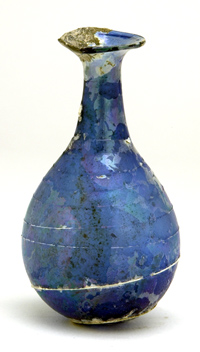 |
Fine Thread-wound Bottle in Deep Blue. Roman, 1st century AD. Cf. Sammlung Oppenlander no. 645. Charming little bottle, delicately blown in deep azure or cerulean glass, with shallow funnel mouth, tapered neck flaring into ovoid body. Starting at neck and ending at base, bottle wound with fine, thin glass thread, apparently of the same blue, rather than in contrasting white. Minor restoration to part of rim, otherwise in choice condition. A few spots of white patina/iridescence, partcularly along last length of threading. Rest of bottle with transparent iridescent in bright reds and greens. Height: 2-7/8". Scarce and sought after subclass of Roman glass, particularly in this eye pleasing blue.
Estimated Value $900-UP.
View details and enlarged photo
| Realized
$1,323 |
Lot 4842 |
 |
A Choice Date Flask. Roman, likely Syria, 1st century AD. Cf. Matheson, Yale, no. 142; Sammlung Oppenlander, no. 477. Height: 2-5/8". Mold blown in fairly thick, this lightly marbled brown glass has an admixture of white creating zones of yellows, and thus a more realistic appearance. The bottle has a flared mouth with an inward folded lip. The textured details on the body are very clear. With a negligible, tiny chip at the exterior of the mouth, otherwise bottle choice and very pristine. A truly special bottle! This series is always desired and sought after by collectors of early blown glass.
Estimated Value $950-UP.
View details and enlarged photo
| Realized
$1,840 |
Lot 4843 |
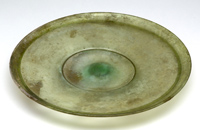 |
Neatly Crafted "Sauce" Plate. Roman, 1st to 2nd century AD. Cf. Sotheby's Constable-Maxwell Collection, lot no. 64. Width: 8-3/4". Blown in a colorful yellow-green glass, this footed plate has a rolled rim that has been folded down and inwards to form a reinforcing rim/angled wall around the plate. The very shallow funnel form with folded foot creates a cup-like center and has a raised central umbo. Intact and perfect. With transparent and subtle, to more vivid iridescence in greens, violets, reds, limes, and magenta. Although light, the dish has been innovatively and ruggedly made. Again this dish is formed to drain sauces or juices to the central reservoir, much like lot no. #4737. Choice and crack free.
Estimated Value $750 - 1,000.
View details and enlarged photo
| Unsold |
Lot 4844 |
 |
Footed Bowl in Aqua. Roman, 1st to 2nd century AD. Width: 5-1/4". Neat and symmetrical, this dish is blown in light aqua-green glass. The bowl has a thick, everted, rolled and folded down rim, short vertical walls, a folded ring foot, and a shallow umbo at its center. The dish is intact and choice. With time-etched surfaces displaying transparent and subtle, yet bright iridescence in greens, violets, reds, limes, and periwinkle. A delightful example of utilitarian ware.
Estimated Value $600 - 850.
View details and enlarged photo
| Unsold |
Lot 4845 |
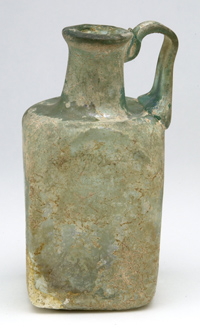 |
Square-bodied Jug in Green. Roman, c. 2nd century AD. Cf. Wolkenburg Collection, Christies' London, 7/9/91, lot 71a. Height: 4-3/4". Blown jug in light green glass, this jug features a short cylinder neck and thick flattened rim. The rectangular body is likely mold-blown to an even, square profile -- although the corners are rounded and the straight walls are a bit concave. A ridged, trailed handle is attched at one side. One lower corner has been restored to match the bottle's crusty, earthen patina. Walls, neck and handle show areas of sometimes vivid green, violet, red, lime, and indigo iridescence. Square-sided bottles remain a less common form in ancient glass.
Estimated Value $450 - 650.
View details and enlarged photo
| Unsold |
Lot 4846 |
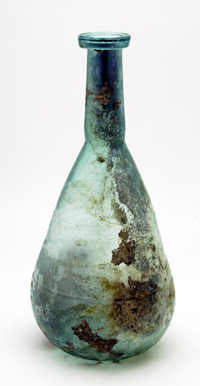 |
Large, Important Wheel-cut Flask. Roman, c. 2nd to 3rd century A.D. Cf. Sammlung Opplander no. 508; and especially a beaker, lot no. 4742, seen previously for like wheel-cut ornament, perhaps from the same workshop. This a grand-sized version in aqua-green glass of the basic bottle/ungentarium shape: cylinder neck atop piriform body, the mouth folded and throated, with rim slightly everted. At regular intervals on neck and body, three broad cut grooves encircle the vessel, these flanked by two narrower sharper grooves. Fabulously preserved for a glass object this size, and with out any of the usual age cracks seen on large heavy glass. Some minor, cleanble black crust, overall with fine transparent iridescence favoring greens and magentas, and muted coppers. Height: 12-1.8". A museum piece, not to be missed!
Estimated Value $2,500 - 3,500.
View details and enlarged photo
| Realized
$3,163 |
Lot 4847 |
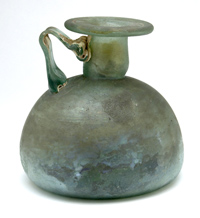 |
Fine Wide-bodied Jug. Roman, c. 3rd century AD. Cf. Sotheby's Constable-Maxwell Collection, lot no. 214. Height: 5-1/8". Robust and blown in light green glass, this distinctive bottle form features a wide plate-like mouth, a lightly flared cylinder neck, and a wide hemispherical body with indented base. The broad, neatly trailed handle has been attached at one side and folded into v-shape. The handle is perhaps in a slightly different green than jug. Intact and perfect, with thick, opaque silvery-violet iridescence along base. A choice and showy bottle.
Estimated Value $750 - 1,150.
View details and enlarged photo
| Unsold |
Lot 4848 |
 |
Decorated Sprinkler Flask. Roman, c. 3rd to 4th century AD. Cf. Oliver, Yale, no. 206. Height: 2-3/4". In light green glass, the body of this flask features a mold-blown design. The bottle has a shallow funnel mouth with rolled lip, a cylinder neck that is constricted at its base with an integral diaphragm, and a piriform-ovoid body. The body has two registers of raised lines in a herringbone pattern, such as seen earlier in lot no. 4763. Intact and perfect, with silvery gray-violet iridescence, with overtones of greens, reds, limes, and blues.
Estimated Value $375 - 575.
View details and enlarged photo
| Unsold |
Lot 4849 |
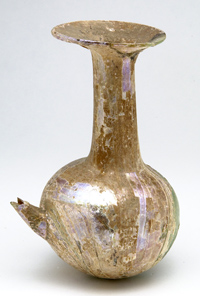 |
Finely Iridescent Feeder Bottle. Roman, 3rd to 4th century AD. Cf. La Baume, Köln, no. 87. Height: 5". Blown from a pale green glass, this bottle has an offset and slightly canted, shallow funnel mouth set upon a long flaring cylinder neck, and a sharply ovoid body. Mid-way on body an upward pointing spout projects. The body is wholly rounded so that the bottle cannot be stood upright. Usual chipping to the spout tip, and a repaired break at mouth with slight loss. Otherwise, the bottle is very fine with exceptional layered, thick iridescence in silvery mauves, plus additional colors ranging from frosted to metallicly bright. A little professional work would make this bottle only better.
Estimated Value $700 - 900.
View details and enlarged photo
| Realized
$472 |
Lot 4850 |
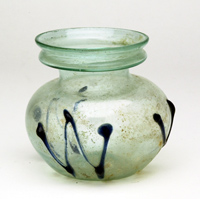 |
Rare Jar with Trailed "Epigraphic" Ornaement. Roman, 3rd to 4th century AD. Jar blown from light aqua-green glass, and of regular, symmetrical shape. Mouth a wide funnel with folded throat, thick short neck, and sharply ovoid body. At three places along side, dark blue glass has been applied in letter-like forms: W V W. Jar pristine and perfect! Height: A very rare variant on a popular class of Late Empire vessels.
Estimated Value $1,500-UP.
The normal form of trailed decoration on this group, and similar squat cosmetic bottles, is a regular continuous zigzag, or spiraling line. A handful are known where the trailed glass actually forms a word or inscription, and this is what seems to be intended on the above jar. For shape and treatment, cf. Newark, no. 178.
View details and enlarged photo
| Realized
$2,760 |
Lot 4851 |
 |
Finely Iridescent Flagon. Roman, c. 3rd to 4th century AD. Cf. Hayes, ROM, no. 425. Height: 3-5/8". Blown in pale green glass, this bottle has a funnel mouth with a flared and folded rim, a narrow neck, and sloping shoulders upon its cylindrical body. A heavy trailed ring of glass has been applied under the rim. A narrow ridged and folded handle appears at one side. Intact and very fine. The age-etched surfaces with delightful iridescence in mellow and warm hues of red, gold, and rose, with accents of violet and green.
Estimated Value $400 - 550.
View details and enlarged photo
| Unsold |
Lot 4852 |
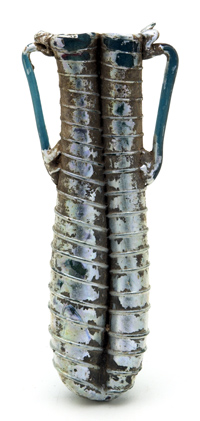 |
Double Unguentarium with Superb Silvery Iridescence. Roman, 3rd to 5th century AD. A wide tube of dark aqua blue glass has been pinched and folded along its middle to form this colorful twin container for cosmetic oils or salves. The original tube with heavy trailed glass thread wound about it, now forming a decorative, somewhat herringbone-like pattern. At mouth and upper sides, two L-shaped handles, trailed from the same deep aqua glass. Intact and perfect,and rare thus. With fabulous thick silvery iridescence, having pastel hints of magenta and green. Length: 5-1/16". A choice, dramatic example of this class.
Estimated Value $1,750-UP.
View details and enlarged photo
| Realized
$2,415 |
Lot 4853 |
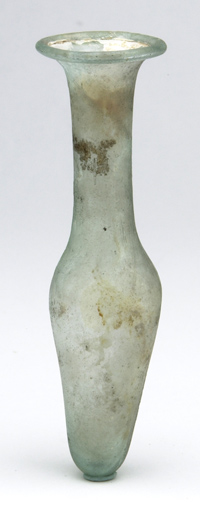 |
Perfume Vial in Aqua Glass. Roman, c. 3rd to 5th century AD. Height: 4-1/4". This bottle is a simple but elegant form with a shallow funnel mouth, a cylindrical neck, and an inverted conical body with sloping and rounded shoulders. The shoulders show regularly spaced light indentations. With an age crack at the thick base, otherwise the bottle stable and very fine. Vial displays slight hints of subdued multi-hued iridescence.
Estimated Value $250 - 350.
View details and enlarged photo
| Realized
$265 |
Lot 4854 |
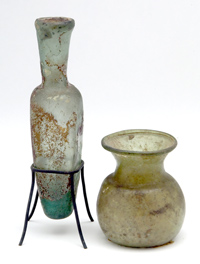 |
Two Small Cosmetic Bottles. Roman Near East, c. 3rd to 5th century AD. Height: 2"; 3-3/4"; the second on metal stand. 1. Earliest, a little jar with a funnel mouth, a broad ovoid body and indented base that is blown in leaf green glass. 2. Next, a square-sided, thick bottomed flask or vial in emerald green glass. The bottle has a narrow, deep funnel mouth and body of inverted, narrow pyramid form. Both are intact and perfect, with little iridescence.
Estimated Value $250 - 400.
View details and enlarged photo
| Realized
$357 |
Lot 4855 |
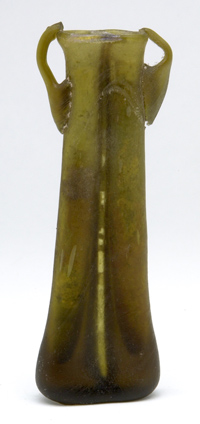 |
Double Balsamarium in Rare Yellow Color. Roman, c. 4th century AD. Height: 4-1/4". In a less common brown-dark yellow glass, this bottle was fashioned from a larger folded and crimped tube. Here the narrow cylinder bodies flare out towards flattened base. Two looped handles have been attached at the sides. The balsamarium is finely preserved, but lacking the central bail handle. Occasional, fine iridescence is violet at the mouths and periwinkle blue at the base.
Estimated Value $400 - 550.
View details and enlarged photo
| Unsold |
Lot 4856 |
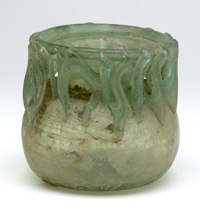 |
Choice Jar with Trailed Ornament. Roman, c. 4th to 5th century AD. Cf. Hayes, ROM, 443; for squat shape, cf. Sotheby's Constable-Maxwell Collection, lot no. 106. Eastern Mediterranean manufacture. Height: 2-3/4". This very robust and stylish example is crafted in light green glass. The jar features a broad funnel mouth with thickly rolled rim and a squat ovoid body with indented base. Quite evenly and regularly spaced around its neck is a thick zigzag trailing of glass in the same green as the jar. Intact and perfect, with little or no iridescence. Choice.
Estimated Value $950 - 1,250.
View details and enlarged photo
| Unsold |
Lot 4857 |
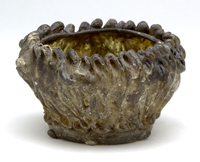 |
Rare Jar with Trailed Glass. Roman Syria, c. 4th to 6th century AD. Height: 1-3/4". In yellow glass, this jar has a bowl-like form with sharply rounded shoulders and walls tapering inward to smaller base all set upon a folded ring foot. The exterior is heavily overlayed with sometimes irregular, but tightly spaced zigzag ribbons of glass. The vessel has been reassembled with modest restoration. Jar displays areas of silvery-black patina, plus scattered speckles of often vivid metallic iridescence. Cf. a late Roman double balsamarium for comparable lavish use of trailed and folded glass ribbons: Sammlung Oppenlander, no. 681b.
Estimated Value $750-UP.
View details and enlarged photo
| Unsold |
Lot 4858 |
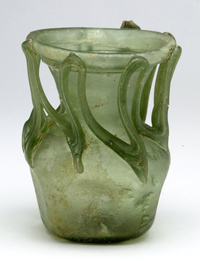 |
Unusual Trailed Glass Jar. Roman, c. 4th to 5th century AD. Cf. Hayes, ROM, 442; for indented walls, Matheson, Yale, no. 310. Eastern Mediterranean manufacture. Height: 3-3/8". An unusual variant of this class. In leaf green glass this jar features a wide and deep funnel mouth, with a broad, rolled and folded rim, and a smallish ovoid body. Lazy, long zigzags of glass connect the mouth and shoulders. Walls of the body are indented, making the bottle pentagonal in section. Intact and choice, with scattered patches of sometimes vivid iridescence. Something different!
Estimated Value $750 - 1,000.
View details and enlarged photo
| Realized
$2,070 |
Lot 4859 |
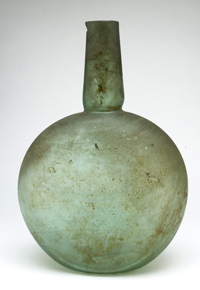 |
Very Large Storage Bottle in Green. Roman, c. 4th to 6th century AD. Cf. Newark, fig. 170. The shape has proved to be surprisingly durable, with similar bottles used in the 16th through 18th centuries for holding wine, transporting madeiras, and even used up to recent times for fancy ports and the like. Height: 11-7/8". Large and robust, tise bottle resembles the canteen-like "Pilgrim's flasks." Blown this green glass the vessel has a slightly flared cylinder neck which is constricted at the base, and a globular body that has been flattened into a thick discoid. With a chip at the rim, otherwise this huge bottle is free of the usual age cracks. Hints of subdued multi-hued iridescence, mostly on one side.
Estimated Value $1,000-UP.
View details and enlarged photo
| Realized
$1,495 |
Lot 4860 |
 |
A Group of Late Antique Bottles. Roman Near East, c. 4th to 6th century AD. An cross section of Late Roman vial shapes, probably originating in Syria. All with slight to broad funnel mouths, short to long cylindrical necks, and body shapes ranging from piriform to ovoid, to barrel, or to conical. Two with pinched or mold blown ribbing along the walls. All are in pale to light green glass, from lightweight to fairly thick. Each intact and choicely preserved, with some patinated almost to the look of custard glass, while one or two with a faint hint of iridescence. Heights: 1-7/8" - 2-3/4". Interesting material. The pontil technique, and consistant glass color, almost suggesting these all might be products of one workshop. Lot of 5 pieces.
Estimated Value $350 - 500.
View details and enlarged photo
| Realized
$334 |
Lot 4861 |
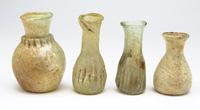 |
Another Group Similar to the Previous Vials. Roman Near East, c. 4th to 6th century AD. The smaller vials akin in all respects to those in the preceding lot. The largest bottle related to the other ribbed bottles, but on this the ribbing relegated to the shoulder, which when the neck was folded inward, became a very distinctive scalloped collar encircling the jar's now shortened neck. Preservation and patinas same as previous, with one small vial with subtle gold, red and green iridescence/patina. Heights: 2-1/4" - 2-3/4". Lot of 4 pieces.
Estimated Value $350 - 450.
View details and enlarged photo
| Realized
$299 |
Lot 4862 |
|
Withdrawn
| Unsold |
Lot 4863 |
 |
Colorful Ushabti. Egypt, XXI Dynasty, c. 1075-944 BC. Height: 5". Faience ushabti of simplified mummiform shape depicting an individual with arms crossed. Faience is glazed in an attractive turquoise blue. Details appear in an applied black glaze. The figure wears a long lappet wig, beaded collar and cuffs, and holds two picks, with seed bag or basket thrown over each shoulder. A panel of hieroglyphs runs down the front of the body and legs. Mounted on black-painted wood base. Artifact is nicely preserved with only a few trivial chips to glaze. Attractive for its type.
Estimated Value $750 - 950.
View details and enlarged photo
| Realized
$1,093 |
Lot 4864 |
 |
Later Ushabti in Deep Blue-Green Faience. Egypt, XXVIII to XXX Daynasty, c. 400-300 BC. Quite pleasing for its type. Height: 3-5/8". Ushabti similar to the previous examples but with clearly molded details. This individual, again, with arms crossed wears a long lappet wig and sepulchral beard and holds a pick and flail. A slab-like pillar runs along his back. This ushabti has very slim proportions, with intense, deep blue-green glaze. Work is nicely preserved with a dark patina over parts of the figure. Also mounted on black-painted wood base.
Estimated Value $250 - 350.
View details and enlarged photo
| Realized
$219 |
Lot 4865 |
 |
Egyptian Faience Lot. Second Intermdiate to Late Periods, c. 1650 -330 BC. Ushabti height: 4-3/8". An attractive strand of "mummy beads" comprised of tiny discs from various dynasties glazed primarily in blues and greens, but also with fine, bright whites, reds, yellows, sienna, and dark brown. The main necklace is made up of five strands, the ends with catches are singles. Also, a Late Dynastic ushabti, c. 400-330 BC, in bluish gray-green. This sepulcheral servant of typical mummiform shape. Along the front of the body is a rectangular panel with hieroglyphs, but these are not legible because of infilling by the thick glaze. Beads perfect; the ushabti is intact and very fine, although glaze now matte.
Estimated Value $300 - 400.
Ex Shirley Barr Sage Collection, published in her Biblical Numismatics: Thirty Pieces of Silver, illustrated and discussed on p. 18.
View details and enlarged photo
| Realized
$184 |
Lot 4866 |
 |
Persian Bronze "Tea Pot". Persian Luristan, circa 8th-7th century BC. A wonderful and curious bronze vessel with long, protruding (open channeled) spout. This is a metal version of this culture's distinctive ceramic vessels, featuring a similar beak-like spout. The pot is a flattened conical shape, with ovoid swelling to the throat of the spout. This surrounded by eleven decorative bosses. Height: 4"; Length: 9". Excellent dark green patina, with touches of red, and free from breaks and repairs.
Estimated Value $300 - 400.
View details and enlarged photo
| Realized
$437 |
Lot 4867 |
 |
Notable Financial Cuneiform Tablet. Akkadian, c. 2300 BC. Size: 1-5/8" x 1-5/8". This tablet is a very fine grain pinkish clay, of squared oval shape. The face of the tablet was divided into quarters and inscribed on three of the sections. In the larger section, a less stylized cuneiform (of this reign) states: "Eight shekels of silver ('on the outside'), [from] En-Ni the trade agent. Lugal-mu having transferred to my tablet, placed in on my debit account." A mnor chip or spall appears on the reverse edge, but does not affect the text. Otherwise, the tablet is finely preserved with good surfaces and exceptionally clear and readable characters. Akkadian tablets are much less encountered and so are always more desirable. Even more rare -- an actual fiduciary transaction is described here, rather than the more typical receipt list of barley, goats, beer, etc.
Estimated Value $375 - 475.
Ex Shirley Barr Sage Collection, published in her Biblical Numismatics: Thirty Pieces of Silver, discussed on p. 11. Translated by Professor Robert Englund of UCLA.
View details and enlarged photo
| Realized
$460 |
Lot 4868 |
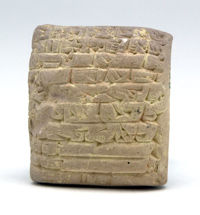 |
Fine Cuneiform Tablet. Third Dynasty of Ur, c. 2112-2004 BC. Size: 1-3/8 x 1-3/16." This tablet is composed of a fine-grained pinkish-gray clay in a rectangular form. Carefully laid out and inscribed in a very neat and precise hand, the text is a receipt for cattle, at "Drehem," and dated to the"fourth month, ninth day of the fort-fifth year of the reign of Shulgi (2094-2047 BC)." Two small ancient scrapes appear towards the edge of the tablet. Otherwise choice and pristine. The cuneiform is artistic and strongly legible. A very fine tablet.
Estimated Value $300 - 400.
Ex Shirley Barr Sage Collection, published in her Biblical Numismatics: Thirty Pieces of Silver, discussed on p. 10. Tablet cleaned and translated by the Babylonian Collection, Sterling Memorial Library, Yale University.
View details and enlarged photo
| Realized
$368 |
Lot 4869 |
 |
Rare Unopened Cuneiform Letter. Old Babylonian, c. 1750 BC. Size: 1-3/4 x 1-5/8." In deep brown clay, this tablet is similar to the previous lot but larger and thicker due to the "envelope" encasing another smaller tablet within. Text appears on both sides, plus two edges. The exterior text mirrors most, if not all of the inscription on the interior tablet. This is also an economic document detailing the receipt of five shekels of silver as interest, reflecting an agreement that was also notarized before witnesses. Envelope is intact and perfect. Again rare and desirable for being an actual transaction in shekels of silver, rather than just an ordinary receipt. But also, this artifact has the immediacy of placing one so very near to the ancient event by the fact that the scribe, who fashioned and then wrote on this tablet, left his finger and palm prints firmly and clearly all over it!
Estimated Value $500 - 600.
Ex Shirley Barr Sage Collection, published in her Biblical Numismatics: Thirty Pieces of Silver, discussed on pp. 12, 13. Translated by Professor Robert Englund of UCLA.
View details and enlarged photo
| Realized
$661 |
Lot 4870 |
 |
Earliest Biblical Currency. Judaea-Palistine, c. 2000-500 BC. Width of largest: 3-1/4". Lot of two bronzes, including an armlet, and a ring or "earring" that would served a multiple of uses -- adornment or objects of barter, objects of intrinsic metal value, or metal pieces of specific size and wieght, and so becoming in effect a "coin" of certain worth. Lastly, three small nuggets of raw gold to the weight of four gerah -- an always acceptable form of currency in the Near East. Ancient bronzes are well preserved with original crusty green patina.
Estimated Value $100 - 200.
Ex Shirley Barr Sage Collection, published in her Biblical Numismatics: Thirty Pieces of Silver, illustrated and discussed on pp. 8, 398.
View details and enlarged photo
| Realized
$144 |
Lot 4871 |
 |
A Choice and Desirable Set of Inscribed Stone Weights. Judaea, c. 7th to 6th century BC. Diameters: 10 mm. to 27 mm. Lot of 8 pieces. These weights are fashioned in colored limestone -- red, or "salmon," brick red, tan, and dark gray. All are domed in shape and nearly approach a sectioned sphere. All are marked on the top with their value -- on the larger a shekel sign (like a X with a cross bar connecting the bottom legs) -- plus additional or other signs instead. In this group are weights of: four shekels, two shekels, one shekel, nezef, beqa (half shekel), five gerah, and four gerah. All are in choice condition, only one or two with minor chips, and but for two, the signs are extremely legible. The beqa and the nezef are worn with the Hebrew inscription only just discernible. Interestingly the nezef had two additional "replacement " signs added in either the Hellenistic or Greco-Roman eras. Rounding out the set is a larger, and scarcer, weight in a fine grain, almost crystalline, limestone of warm gray color. Clearly seen on it is a V mark, the Judaean equivalent of "4," plus off to the side a faint "I." This weight 90 grms., equaling eight shekels. This with a few minor chips on the bottom. Rare and desirable artifacts!
Estimated Value $1,750-UP.
Ex Shirley Barr Sage Collection, published in her Biblical Numismatics: Thirty Pieces of Silver, illustrated and discussed on pp. 4-7. In ancient Israel there were seven weights that were related to metal, and which were mentioned in the Bible: the talent, mina, shekel, beka, gerah, pim, and kesitah. Three of them are found in this lot. This set is about as fine a one that can be found on the market these days. It is the effort of many years of searching and collecting, since the inscribed examples range from scarce to very rare. An equally fine set was auctioned off in Israel several years ago, to the tune of nearly $3000! Don't pass this one up.
View details and enlarged photo
| Realized
$2,415 |
Lot 4872 |
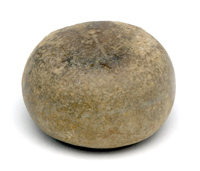 |
A Rare, Larger Inscribed Stone Weight. Judaea, c. 7th to 6th century BC. Another shekel weight like previous, but much larger. This more of a discoid shape, is carved from a warm colored gray limestone and weighs 153 grms., approximately 14 shekels, or a quarter of a mineh. Although well worn, the X-like vestiges of the shekel sign is clearly visible. Weight generally in very fine condition. Large inscribed examples tend to be very rare. Diameter: 52 mm.
Estimated Value $400-UP.
Ex Shirley Barr Sage Collection, published in her Biblical Numismatics: Thirty Pieces of Silver, illustrated and discussed on p. 7.
View details and enlarged photo
| Realized
$661 |
Lot 4873 |
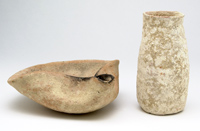 |
Pottery from the Time of the Patriarchs. Judaea c. 2500-1500 BC. A pair of quality early ceramic artifacts. Beaker height: 4-3/4". Lamp width: 5-1/2". 1. The earliest is a beaker in red ware that is coil-formed rather than wheel turned, accounting for its asymmetrical shape. 2. A later date wheel-made bowl which has been folded on two sides to form an ingenious lamp. Both are fine examples, and finely preserved. The beaker is scarce. Choice and fascinating artifacts from Judaea's earliest period.
Estimated Value $300 - 450.
Ex Shirley Barr Sage Collection, published in her Biblical Numismatics: Thirty Pieces of Silver, illustrated and discussed on p. 16.
View details and enlarged photo
| Realized
$230 |
Lot 4874 |
 |
Ancient Judaean Stirrup-Jar. Late Bronze Age II, c. 1450-1200 BC. Height: 4-1/4". An interestingly shaped vessel, peculiar to its time and derived from Mycenaean prototypes. Potted in a moderately fine-grained buff-pink clay, the vessel has a biconical body, short cylindrical neck and small mouth set before its E-shaped "stirrup" handle. With creme slip and the remains of circular ornamental bands in dark brown that appear on both the body and the handle. Slight chip to the shoulder, otherwise nicely preserved, with earthen and whitish patina. Said to have been found at Beth-Shemesh (Canaan). The manufacture and painting is quite fine, so this is most likely a direct Mycenaean import, rather than a local Cypro-Palestinian replica. Rare, and a desirable shape for the ceramic collector. Cf. Amiran, p. 181, fig. nos. 183, 191.
Estimated Value $400-UP.
Ex. Antiquities Gallery, no. 152, about 1983. Ex Shirley Barr Sage Collection, published in her Biblical Numismatics: Thirty Pieces of Silver, illustrated and discussed, pp. 16,17.
View details and enlarged photo
| Realized
$719 |
Lot 4875 |
 |
Small Spouted Juglet, Palestine, c. 800-587 BC. (Iron Age IIc or III). This interesting little juglet is made from a dark gray ware, with cylindrical neck and short cylindrical foot. A slim spout projects out of its globular body, while a ring handle is attached to the side. Nicely preserved, this is one of the distinctive vessel shapes found in the Holyland in this time period. Height: 3-3/8".
Estimated Value $100 - 150.
View details and enlarged photo
| Realized
$104 |
Lot 4876 |
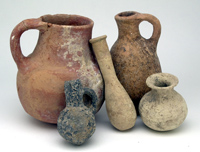 |
Judaean Timeline in Ceramics. Judaea-Palestine, c. 1000 Bc to 200 AD. Lot of five different pieces spanning major periods in Judaean history. Heights: 3" - 5-3/4". From the Age of Kings, the two smaller handled juglets were forms that David and Solomon would have been familiar with. Later, but pre-Exile, is a small buff-colored pot. The small alabastron probably dates to the Maccabean era, whereas the red-slipped jug might have been a type the Apostles or the defenders of Masada could have used. The larger jug is repaired at the handle, while the rest are well preserved and in very fine condition. A nice group -- these a tactile presence of ancient lives.
Estimated Value $400 - 650.
Ex Shirley Barr Sage Collection, published in her Biblical Numismatics: Thirty Pieces of Silver, illustrated and discussed on pp. 19, 22, 23.
View details and enlarged photo
| Realized
$460 |
Lot 4877 |
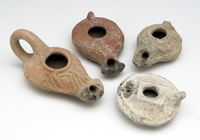 |
Judaean Lamps, c. 50-700 AD. Lengths: 3" - 5". The classic artifact from Judaea. Lamps conjure up images of the daily and personal doings of the peoples of antiquity. They are also, allegorically, a symbol of the people of the Book. Here we find four types spanning the ages and the fortunes of Judaea. The earliest, the Southern type, with red slip and sharply molded petal ornament. Later, a handled lamp with enigmatic tree symbol which may have served as a mnemonic symbol of the menorah in the age of the diasporah. The two remaining date to the times of Jerusalem's Christian and Islamic regimes. All nicely preserved, with soot stains on the nozzels showing use.
Estimated Value $300 - 400.
Ex Shirley Barr Sage Collection, published in her Biblical Numismatics: Thirty Pieces of Silver, illustrated and discussed on pp. 21, 22.
View details and enlarged photo
| Realized
$230 |
Lot 4878 |
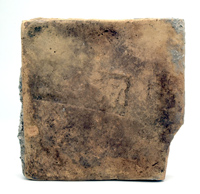 |
A Fine, Nearly Complete Tile of the Tenth Legion, from Ancient Jerusalem. Israel, late 1st to 2nd century AD. The tile, a paver, is fashioned from a gritty pinkish-orange clay and hard-fired. A square of 7" on each side, and about 1 ½" thick, the tile has impressed on its face a rectangular stamp with the letters "LEG X FR". This stands for "Legio Decima Fretensis." One moderate chip at corner, otherwise the tile is intact. The letters are clearly impressed on this tile, making it a desirable example. An important artifact for the Judaica or military collector.
Estimated Value $750 - 850.
Stationed in Palestine and Syria, the Tenth Legion made up the forces that Vespasian employed in Northern Israel during his campaign of 66 AD. later, the legion comprised a good portion of the troops that destroyed Jerusalem under Titus. Three years later they completed the mopping up of the First Revolt when the captured Masada. Afterwards, the Tenth Legion became the official permanent garrison for the province of Judaea. Following the Bar Kochba revolt, the legion was stationed in Jerusalem (which was renamed Aelia Capitolina by Hadrian) itself. In the early 1990's a major Tenth Legion site was discovered during excavations for a parking lot next to the National Auditorium in Jerusalem. At that time a number of like tiles came on the market, but these have long since been dispersed. See: N. Avigad, Discovering Jerusalem, 1980, P. 206, figs. 2, 3 and 4.
View details and enlarged photo
| Realized
$920 |
Lot 4879 |
 |
A Tile Fragment from the Tenth Legion. A Choice Tile Fragment of the Tenth Legion, Israel, Jerusalem, late 1st- 2nd century AD. The tile, another paver, is a little different from the other examples, is fashioned from a gritty orange-tan clay and hard-fired. Again, a square of 7" on each side, and about 1 ½" thick. Here about two thirds of the tile present. Of the legionary stamp, "LEG X" remains. The impression bold, and the letters stand out clear. The tile face clean and with little wear. On the back a thick layer of the mortar still adheres; this, interestingly shows the use of crushed shells as filler. A fine example, and very affordable. Size: 7" x 6".
Estimated Value $350 - 500.
View details and enlarged photo
| Realized
$460 |
Lot 4880 |
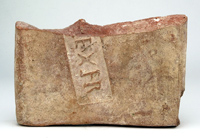 |
Another Choice Tile Fragment of the Tenth Legion, Israel, Jerusalem, late 1st - 2nd Century AD. The tile, another paver, is a little different from the previous examples. The clay is a little finer grain, and a deep pink color. This one a square of about 7¼" on each side, and about 1¼" thick. Here about half of the tile present, with three quarters of the legionnary stamp remaining: "…E X FR". This stamp with a shortened inscription, and in a smaller, more delicate style. The extant impression bold, the letters very clear. The tile face clean and with only minimal wear. Small collection number inked on the side. Again, a fine example, and very affordable. Size: 7¼ x 4¾".
Estimated Value $350 - 500.
View details and enlarged photo
| Realized
$288 |
Lot 4881 |
|
Withdrawn
| Unsold |
Lot 4900 |
|
Canada and British coins and medals. This box lot includes a wide selection of circulated Canadian small silver and copper coins, mainly early 20th Century, plus a few British and Commonwealth issues. Also, complete sets of 1976 and Calgary Olympic five and ten silver dollar sets, including the wooden display rack for the first. Along with these, an assortment of British and Canadian Mint sets, plus Caribbean proof coins. Also some interesting odds and ends from the Franklin Mint, in pewter, a letter stamp seal with four sticks of wax, a key for members, a letter opener, an assortment of different numismatic societies medals. Worth a look. Many of the newer pieces in the original boxes or cases. Sold as is, no returns.
Estimated Value $300-UP.
View details
| Realized
$184 |
Lot 4901 |
|
Turks & Caicos. Gold Coins as follows. 25 Crowns, KM-9.2 Proof; 50 Crowns, KM-3 Proof, KM-10 Proof, KM-20 Proof; 100 Crowns, KM-4 Proof, KM-11 Proof, KM-17 Proof (mintage of 350 pieces), KM-46 Proof, KM-50 Proof, KM-54 Proof and KM-59 Proof (mintage of 565 pieces). A nice group of gold coins for the collector. Lot of 11 pieces.
Estimated Value $800 - 1,100.
View details
| Realized
$460 |
|
|